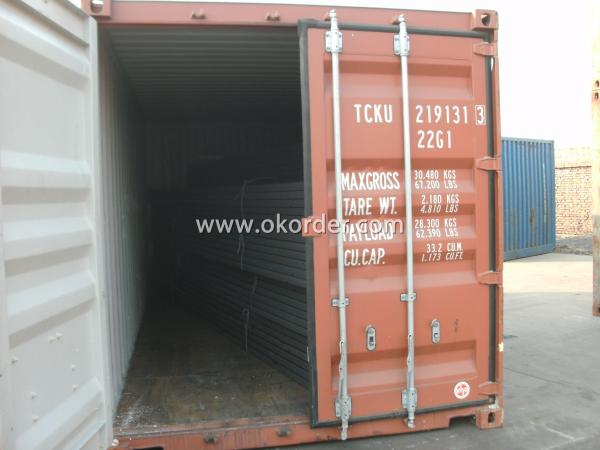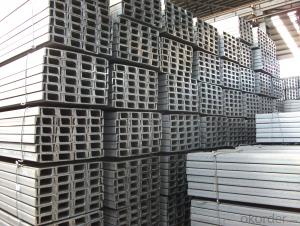Hot Rolled Steel U Channel
- Loading Port:
- China Main Port
- Payment Terms:
- TT or LC
- Min Order Qty:
- -
- Supply Capability:
- -
OKorder Service Pledge
OKorder Financial Service
You Might Also Like
Product Description:
OKorder is offering high quality Channel Steel at great prices with worldwide shipping. Our supplier is a world-class manufacturer of steel, with our products utilized the world over. OKorder annually supplies products to European, North American and Asian markets. We provide quotations within 24 hours of receiving an inquiry and guarantee competitive prices.
Product Applications:
Channel Steel is usually used for building structure, vehicle manufacturing and other industrial structure and often used with i beam.
In details, the channel steel belongs to carbon structural steel which is applied to in the field of construction and machinery. The channel steel is usually used for arch-itechtural structure, and they could be welded in order to support or hang a vari-ety of facilities. They are also usually used in combination with I beam. Generally,the channel steel must possess perfect welding property, riveting property and mechanical property and so on.
Product Advantages:
OKorder's Channel Steel are durable, strong, and resist corrosion.
Main Product Features:
· Premium quality
· Prompt delivery & seaworthy packing (30 days after receiving deposit)
· Corrosion resistance
· Can be recycled and reused
· Mill test certification
· Professional Service
· Competitive pricing
Product Specifications:
| Original Place | Tangshan, China | Brand Name | Bridge |
| Standard | GB707-88, EN100025, JIS G3192, DIN 1026 | ||
| Sizes | 50mm to 300mm | ||
| Sales Volume/Year | 3000MT | ||
| Main Market | Middle East, Africa, Southeast As | ||
1.We are able to provide channel steel of top quality at attractive price.
2.Our products of channel steel have passed ISO9001:2008 Quality Management System Certification.
3. The section of JIS Standard Channel Steel are as followings in the table.
| JIS U CHANNEL | Standard h | Sectional b | Dimension s | t | Mass: Kg/m |
| (mm) | (mm) | (mm) | (mm) | ||
| 50x25 | 50 | 25 | 3.0 | 6.00 | 2.37 |
| 75X40 | 75 | 40 | 3.8 | 7.00 | 5.30 |
| 75X40 | 75 | 40 | 4.0 | 7.00 | 5.60 |
| 75X40 | 75 | 40 | 4.5 | 7.00 | 5.85 |
| 75X40 | 75 | 40 | 5.0 | 7.00 | 6.92 |
| 100X50 | 100 | 50 | 3.8 | 6.00 | 7.30 |
| 100X50 | 100 | 50 | 4.2 | 6.00 | 8.03 |
| 100X50 | 100 | 50 | 4.5 | 7.50 | 8.97 |
| 100X50 | 100 | 50 | 5.0 | 7.50 | 9.36 |
| 125X65 | 125 | 65 | 5.2 | 6.80 | 11.66 |
| 125X65 | 125 | 65 | 5.3 | 6.80 | 12.17 |
| 125X65 | 125 | 65 | 5.5 | 8.00 | 12.91 |
| 125X65 | 125 | 65 | 6.0 | 8.00 | 13.40 |
| 150x75 | 150 | 75 | 5.5 | 7.30 | 14.66 |
| 150x75 | 150 | 75 | 5.7 | 10.00 | 16.71 |
| 150x75 | 150 | 75 | 6.0 | 10.00 | 17.90 |
| 150x75 | 150 | 75 | 6.5 | 10.00 | 18.60 |
4. Chemical Compostion of JIS Standard Channel Steel
| Grade | Element(%) | |||
| C | Mn | P | S | |
| SS330 | -- | -- | ≦0.050 | ≦0.050 |
| SS400 | ||||
| SS490 | ||||
| SS540 | ≦0.30 | ≦1.60 | ≦0.040 | ≦0.040 |
Package & Delivery of Channel Steel:
The steel u channel will be packed in bundle with steel wire at each end of every bundle and color marking in order to help the customer to recognize his goods more easily at sight.
And steel u channel could be loaded into 20ft or 40ft container, or by bulk cargo. If the weight of each bundle reaches less than 3.5 mt, the loading by break bulk cargo should be choosed. When the weight of each bundle reaches less than 3mt, the loading by container should be choosed.
As for the transportaion from mill to loading port, the truck will be usually used. And the maximum quantity for each truck is 40mt.
All in all, we could do in accordance with customer's request.


Production Flow of Channel Steel:
1.The steel billet shall be heated in the high temperature furnace.
2. The heated steel billet shall be rolled five to nine times with the aim of shaping the general figure of steel u channel.
3. The rolled steel u channel should be put onto the cooling bed to make the temperature low.
4. The steel u channel should be straighted on the straightener.
5. The straighted steel u channel will be cut into meters by saw, as per customer's requirements.
FAQ:
Q1: Why buy Materials & Equipment from OKorder.com?
A1: All products offered byOKorder.com are carefully selected from China's most reliable manufacturing enterprises. Through its ISO certifications, OKorder.com adheres to the highest standards and a commitment to supply chain safety and customer satisfaction.
Q2: How do we guarantee the quality of our products?
A2: We have established an advanced quality management system which conducts strict quality tests at every step, from raw materials to the final product. At the same time, we provide extensive follow-up service assurances as required.
Q3: How soon can we receive the product after purchase?
A3: Within three days of placing an order, we will begin production. The specific shipping date is dependent upon international and government factors, but is typically 7 to 10 workdays.
- Q:How do steel channels perform in high-wind areas?
- Steel channels perform well in high-wind areas due to their strength and durability. The structural integrity of steel channels allows them to withstand the strong forces exerted by high winds, providing stability and resistance against potential damage or collapse.
- Q:Can steel channels be used in the telecommunications parts manufacturing industry?
- Indeed, the telecommunications parts manufacturing industry can utilize steel channels. With their versatility and extensive range of applications, steel channels prove instrumental in supporting and ensuring the structural integrity of various equipment and components employed within the telecommunications sector. These channels are capable of constructing robust frames, racks, brackets, and other essential structural elements necessary for housing and securing telecommunications equipment. Given their exceptional strength and durability, steel channels are well-suited to withstand the demanding loads and adverse conditions commonly encountered in telecommunications infrastructure. Furthermore, owing to their ease of customization and fabrication, steel channels can be tailored to meet the specific requirements of telecommunications parts, thereby facilitating efficient and cost-effective manufacturing processes.
- Q:How do steel channels contribute to the overall material efficiency of a structure?
- The role of steel channels in enhancing the material efficiency of a structure cannot be understated. These crucial structural elements are specifically designed to provide strength and support to various components of a structure, optimizing the utilization of materials in a manner that is cost-effective. To begin with, steel channels are renowned for their remarkable strength-to-weight ratio. This means that they can bear significant loads while being relatively lightweight themselves. By incorporating steel channels, engineers can minimize the quantity of materials required to support the structure, leading to a more efficient utilization of resources. This becomes particularly crucial in large-scale projects, where reducing the overall weight of the structure can result in substantial cost savings. Furthermore, steel channels offer flexibility when it comes to design and construction. Their uniform shape and standardized dimensions allow for effortless integration into diverse structural systems. This diminishes the necessity for customized fabrication and simplifies the construction process. Consequently, the overall material efficiency of the structure is enhanced, as there is minimal waste of resources during the construction phase. Moreover, steel channels make a significant contribution to the overall durability and longevity of the structure. Steel is well-known for its resistance to corrosion, fire, and other environmental factors. This guarantees that the structure remains intact and functional for an extended period, reducing the need for frequent maintenance or replacement. By utilizing steel channels, the overall lifespan of the structure is extended, leading to an improved material efficiency. In conclusion, the significance of steel channels in enhancing the material efficiency of a structure cannot be overstated. Their exceptional strength-to-weight ratio, design versatility, and durability all contribute to minimizing material usage, simplifying construction, and prolonging the longevity of the structure. By incorporating steel channels into the structural design, engineers can optimize the utilization of materials, resulting in a more sustainable and cost-effective solution.
- Q:Can steel channels be used for HVAC systems?
- Indeed, HVAC systems can utilize steel channels. Owing to their robustness and longevity, steel channels frequently serve as a pivotal element in HVAC systems. Not only can they provide support and stability for ductwork, but they can also furnish a framework for the integration of HVAC equipment like air handling units, fans, and filters. Varied sizes and configurations of steel channels are accessible to meet diverse HVAC system specifications. Moreover, HVAC professionals favor steel channels due to their effortless fabrication and installation process.
- Q:How do steel channels perform in corrosive environments?
- The durability and strength of steel channels are widely recognized, but their performance in corrosive environments can vary depending on the type of steel used and the severity of the conditions. In general, steel channels resist corrosion due to the formation of a protective oxide layer when exposed to oxygen in the air. This layer acts as a barrier, preventing further oxidation and protecting the steel. However, exposure to corrosive environments like saltwater or industrial chemicals can compromise this protective layer, leading to potential corrosion. To enhance the performance of steel channels in corrosive environments, corrosion-resistant alloys or coatings can be used. Stainless steel channels, for instance, contain chromium and other elements that offer excellent corrosion resistance. These channels are highly resistant to rust and can withstand even the most challenging conditions. In more severe corrosive conditions, additional protective measures like galvanizing or epoxy coatings can be applied. Galvanizing involves coating the steel with a layer of zinc, which acts as a sacrificial anode, protecting the underlying steel. Epoxy coatings create a barrier between the steel and the corrosive environment, minimizing the risk of corrosion. It's important to note that despite these protective measures, steel channels may still experience corrosion over time, especially without proper maintenance. Regular inspection, cleaning, and maintenance can help identify and address any signs of corrosion early on, extending the lifespan and performance of the steel channels in corrosive environments. Overall, while steel channels can perform well in corrosive environments, it's crucial to consider the specific conditions and choose the appropriate type of steel, coatings, or alloys to ensure optimal performance and longevity.
- Q:Are steel channels suitable for railway tracks?
- Steel channels are not suitable for railway tracks. Railway tracks require a specific type of steel rail that is designed to withstand the heavy loads and constant use of trains. Steel channels, on the other hand, are typically used in construction for structural support and do not have the necessary strength and durability to serve as railway tracks. Additionally, steel channels lack the necessary shape and design features, such as the proper rail profile and fastening system, required for safe and efficient railway operations. Therefore, it is essential to use dedicated steel rails specifically designed for railway tracks to ensure the safety and functionality of the railway system.
- Q:How can channel A and B be distinguished?
- In general, B is thicker than a and 2mm thick.
- Q:How do steel channels contribute to the stability of cantilevered structures?
- Steel channels contribute to the stability of cantilevered structures in several ways. Firstly, steel channels are known for their high strength and durability, making them ideal for supporting heavy loads and resisting external forces. When used as a structural component in cantilevered structures, they provide the necessary support and stability to counteract the bending moments and shear forces that act on the structure. Secondly, steel channels have a U-shaped cross-section, which enhances their load-bearing capacity and resistance to bending. This shape allows for a more efficient distribution of forces, preventing excessive deflection and ensuring the structural integrity of the cantilever. Furthermore, steel channels are often used in combination with other structural elements, such as beams and columns, to form a rigid framework. This framework provides additional support and stiffness to the cantilevered structure, preventing any excessive movement or deformation. Additionally, the versatility of steel channels allows for various configurations and connections, enabling engineers to design cantilevered structures with different shapes and sizes to suit specific needs. This adaptability ensures that the structure can withstand different loads and environmental conditions, enhancing its overall stability. Lastly, steel channels can be fabricated to precise dimensions, ensuring accurate alignment and assembly during construction. This precision in fabrication and installation minimizes any potential weak points or gaps in the structure, further enhancing its stability and safety. In conclusion, steel channels contribute significantly to the stability of cantilevered structures by providing high strength, load-bearing capacity, and resistance to bending. Their U-shaped cross-section, versatility, and precise fabrication also play vital roles in ensuring the overall stability and integrity of these structures.
- Q:What are the standard sizes of steel channels?
- The standard sizes of steel channels vary depending on the specific requirements and standards set by different countries and industries. However, some commonly used standard sizes for steel channels include C3x4.1, C6x8.2, C10x15.3, C12x20.7, C15x33.9, C18x54.7, C20x66, and C24x80. These sizes are measured in inches and represent the dimensions of the channel, such as height, width, and weight per foot.
- Q:Can steel channels be used for creating support structures for material handling systems?
- Yes, steel channels can be used for creating support structures for material handling systems. Steel channels are a popular choice for support structures due to their strength, durability, and versatility. They provide a stable and reliable framework that can withstand heavy loads and provide long-term support for material handling systems. Additionally, steel channels can be easily customized and fabricated to meet specific requirements, making them suitable for various types of material handling equipment such as conveyors, racks, and shelving systems. Overall, steel channels offer a robust solution for creating support structures for material handling systems.
1. Manufacturer Overview |
|
|---|---|
| Location | |
| Year Established | |
| Annual Output Value | |
| Main Markets | |
| Company Certifications | |
2. Manufacturer Certificates |
|
|---|---|
| a) Certification Name | |
| Range | |
| Reference | |
| Validity Period | |
3. Manufacturer Capability |
|
|---|---|
| a)Trade Capacity | |
| Nearest Port | |
| Export Percentage | |
| No.of Employees in Trade Department | |
| Language Spoken: | |
| b)Factory Information | |
| Factory Size: | |
| No. of Production Lines | |
| Contract Manufacturing | |
| Product Price Range | |
Send your message to us
Hot Rolled Steel U Channel
- Loading Port:
- China Main Port
- Payment Terms:
- TT or LC
- Min Order Qty:
- -
- Supply Capability:
- -
OKorder Service Pledge
OKorder Financial Service
Similar products
New products
Hot products
Hot Searches
Related keywords




























